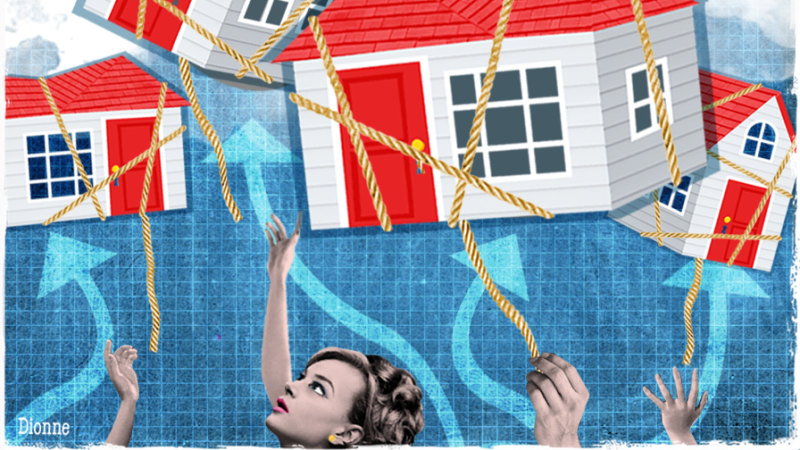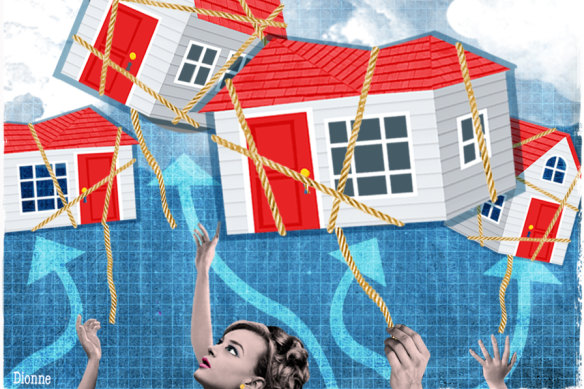Help! How to prepare for your fixed rate mortgage ‘cliff’
Ok, Philip Lowe, you have my attention now.
I, like many Aussies, spent this summer in a pleasant haze of ‘revenge spending’ on holidays, parties and going out – a welcome reprieve after several summers of rain and lockdowns.
But our Reserve Bank governor and his fellow board members, who together determine the level of interest rates in this country, have returned from their own summer holidays with this stern message for anyone with a mortgage: it is time to stop spending. Like, yesterday.
Nearly one million Australians are set to roll off their low-rate fixed mortgages this year. Here’s what you can do to prepare.Credit:Dionne Gain
If we don’t, Lowe and Co have made it clear they are hellbent on increasing interest rates until we do. ANZ bank economists are now tipping three more rate hikes to come.
Households with variable-rate loans are already feeling the pain. But perhaps the biggest shocks await those borrowers – including me – who took out ultra-low fixed-interest rate loans during COVID. Such borrowers – an estimated 800,000 this year – now face rolling off from mortgages with a ‘1’ per cent in front, to variable rates with a ‘6’ per cent in front. Ouch.
Make no mistake: some households will be unable to afford such increases. If you are in this camp, call the National Debt Helpline on 1800 007 007 (think James Bond) as soon as you can. This is a government-funded service that connects you to free financial counselling. They can help you negotiate altered repayment plans with your lender or other creditors, like phone and electricity companies.
For the rest of us who aren’t quite in that predicament, but will certainly be facing a cash squeeze in the months ahead, here is what I suggest.
Number 1. Accept your behaviour has to change – that is the whole point
The Reserve Bank is not actually deliberately trying to send households into default on their loans and the economy into recession (although there is certainly a risk they accidentally will). What the bank is really trying to do is to cool ‘aggregate demand’ in the economy, which is the ability and willingness of households to spend money.
Why? Because when consumers head to the shop with a mindset of ‘Oh, I’ll just buy anything I want’, it is all too easy for companies to jack up their prices. That’s called inflation.
Instead, the RBA wants you heading to the shop with an activist, price-sensitive mindset of ‘Can I really afford this?’. It wants you to examine prices like a hawk, putting things back on the shelves, getting by with less, skipping meals out and staying at home. That will reduce spending in the economy, sending the all-important signal to businesses they can’t simply keep jacking up prices any more.
Sapping spending power by ratcheting up borrowing costs is the only blunt tool the Reserve has at its disposal to achieve this mindset shift for both consumers and businesses.
So, read the room: stop spending.
Number 2. Know your cash flow
The scariest prospect in personal finance is being unable to pay for the things you need to live. Are you currently spending less than you earn? Will you still be in positive cash flow when your mortgage repayments rise?
Don’t know? Don’t live in fear, get a budget – which I define as simply any written statement of your income and expenses. Pick a time period – be it a fortnight, a month or a year – and try to figure out what surplus cash you have left over when you subtract your expenses from your income.
Commit to tracking your spending today, with whatever method you prefer, be it a spreadsheet or blank notebook or my own spending tracker here.
Use the Moneysmart online ‘mortgage calculator’ to play with scenarios for what your loan repayments will be after another two or three more rate hikes. Still in surplus? Great. If not, read on…
Number 3. Cut back your expenses
After housing, food is the biggest expense for most families. So delete UberEats from your phone and get savvy shopping: look for discounted meats and freeze them, watch for 50 per cent off specials, try home-branded products and shop at alternative supermarkets. At home, be ruthless against food waste, batch cook and freeze meals and shop your pantry before buying more stuff.
Insurances are another area many people overlook. Regularly review your coverage on health, car and home insurance. Increasing your ‘excess’ – the amount you agree to pay out of pocket in the event of a claim – will lower your ongoing premiums. Don’t pay for health insurance ‘extras’ cover if you don’t really use it. Explore a low ‘agreed value’ policy on your car insurance compared to a full ‘market value’ policy.
Number 4. Investigate options for boosting your income
Ask for a pay rise. If you’ve had no joy for several years, start exploring alternative jobs and employers. I’m a big fan of making sure you are paid appropriately in your main job, but you can also look into side hustles that align with your interests, like dog walking, or lawnmowing, or freelance writing.
Number 5. Get ready to refinance
At least two months out from your fixed rate ending, start talking to mortgage brokers or alternate lenders. Many are offering ‘cash back’ offers of up to $5000 to switch. Plus you’ll often score a lower rate as a new customer. Look at comparison sites like Finder, RateCity, Canstar and Compare the Market.
According to the Reserve Bank, there is about half a percentage point difference between the average variable interest rate on mortgages to new customers, versus the average being paid on all outstanding variable rate loans – so it pays to shop around.
Finally and most importantly, please don’t get stuck in a mindset of overwhelm and anxiety at the prospect of higher interest rates. You are not alone and there are things you can do to stay ahead of rising costs.
- Advice given in this article is general in nature and is not intended to influence readers’ decisions about investing or financial products. They should always seek their own professional advice that takes into account their own personal circumstances before making any financial decisions.
Jessica Irvine is author of Money with Jess: Your Ultimate Guide to Household Budgeting. You can follow more of Jess’ money adventures on Instagram @moneywithjess and sign up to receive her weekly email newsletter.
Most Viewed in Money
From our partners
Source: Read Full Article


